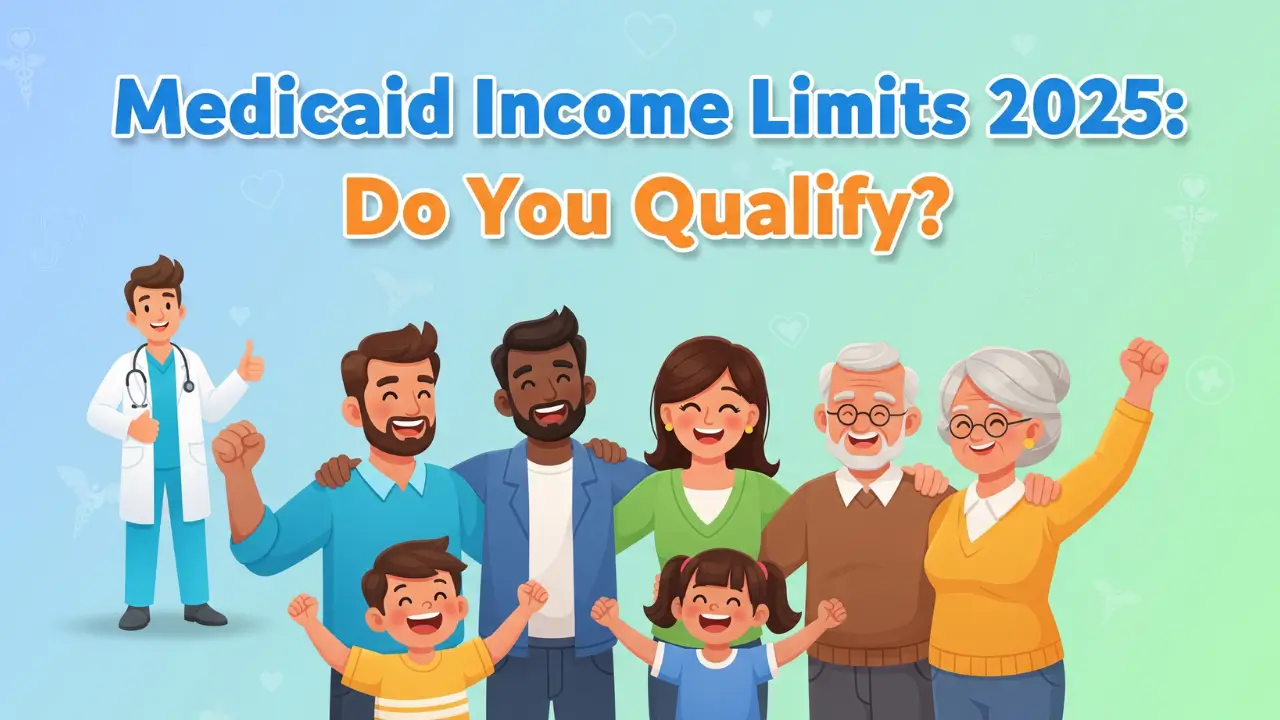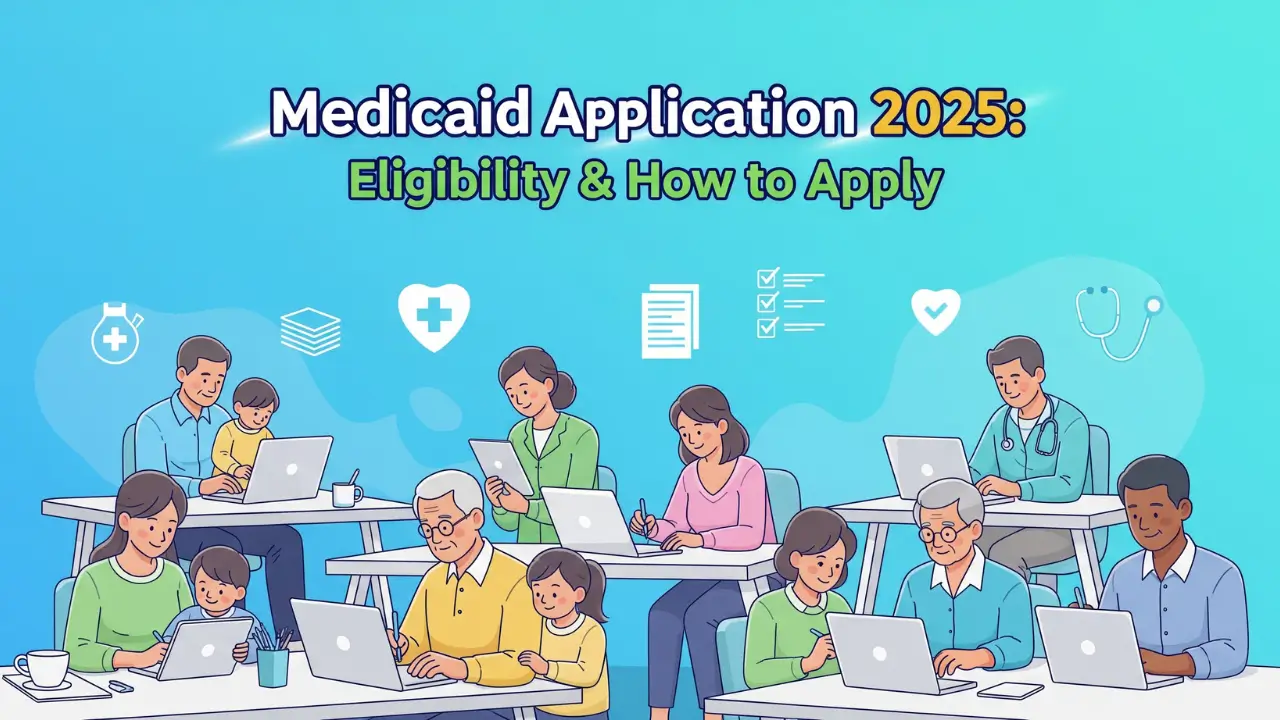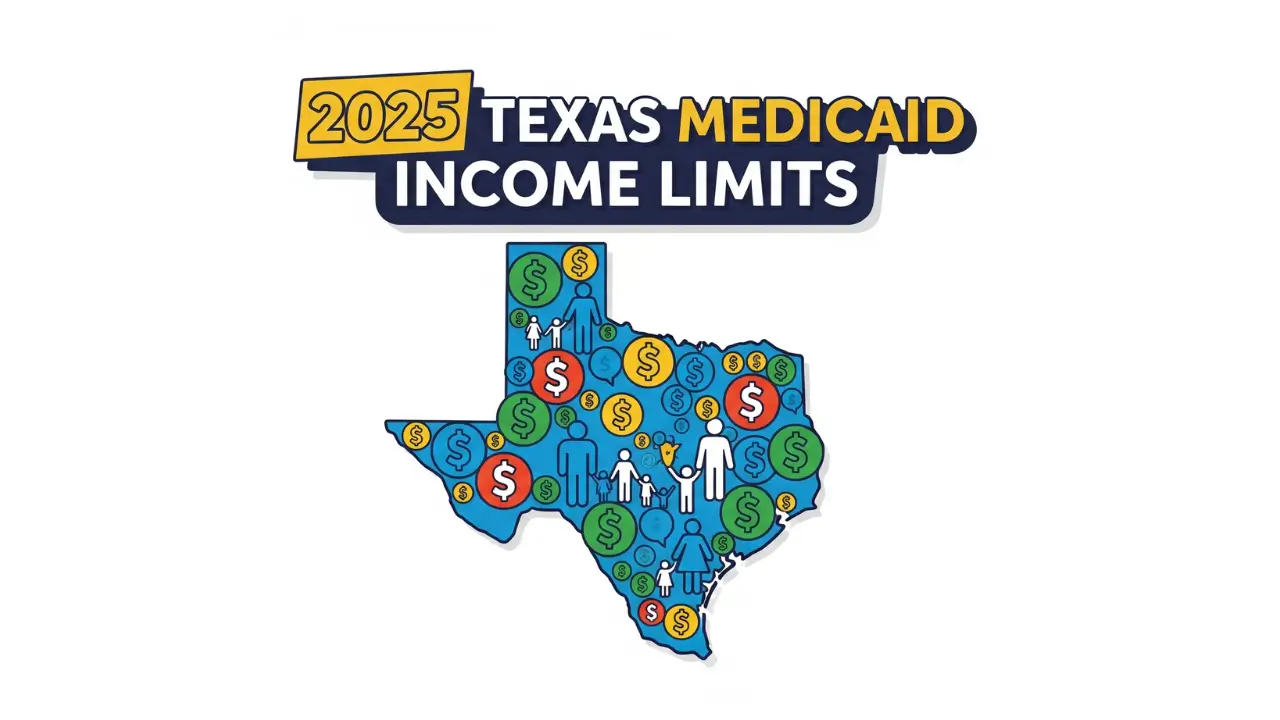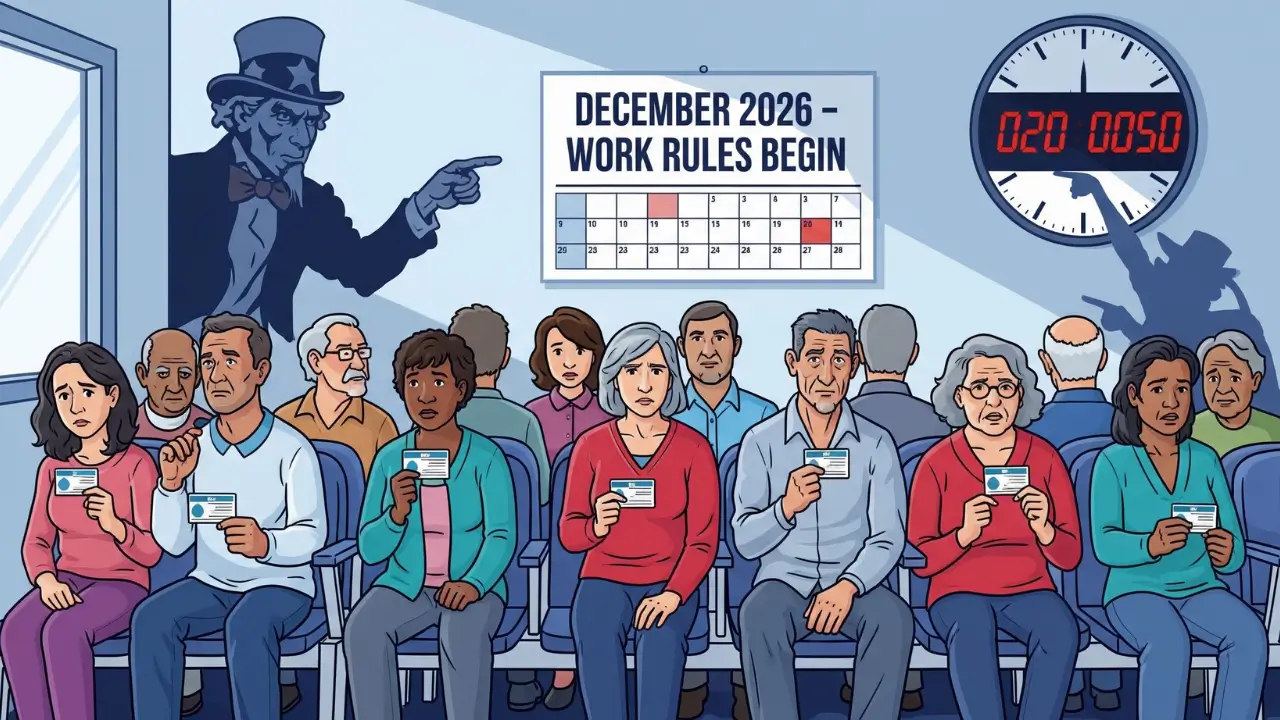Want to know if you qualify for Medicaid in 2025? Here’s the quick answer:
- In most states that expanded Medicaid, adults can qualify if their income is up to 138% of the Federal Poverty Level (FPL) — about $21,600/year for a single adult or $44,400/year for a family of four.
- Each state sets its own rules, so your limit may be higher or lower.
- Special groups like children, pregnant women, seniors, and people with disabilities often have higher limits.
- You can apply online, by phone, by mail, or in person.
💡 Tip: To get a quick estimate for your situation, use our Medicaid Calculator. It helps you see if you qualify based on your state, income, and household size.
2025 Medicaid Income Limits by Household Size
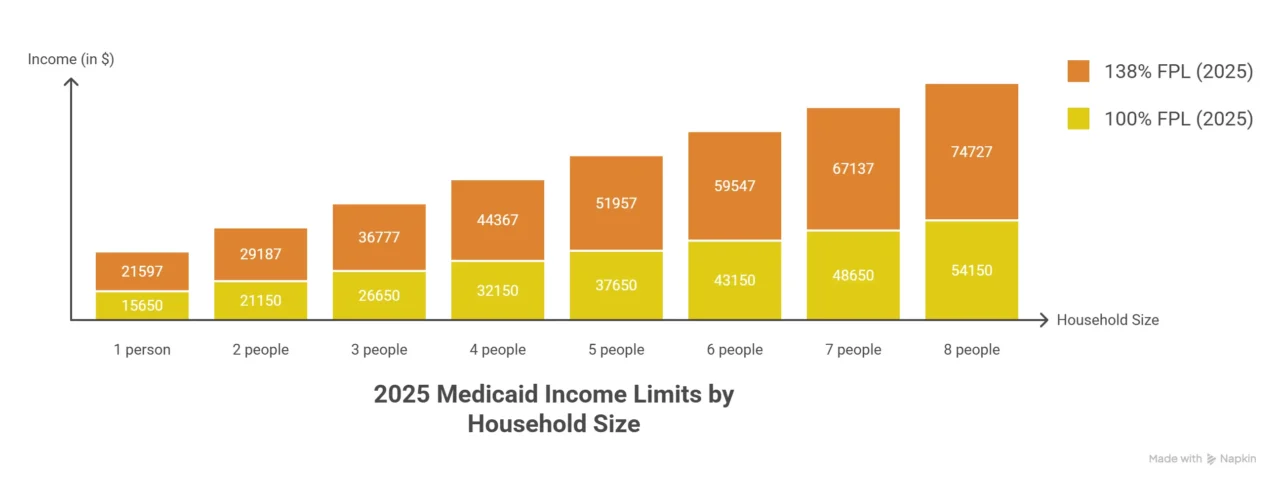
Here are the newest 2025 federal poverty guidelines. Medicaid programs use these numbers to decide if you qualify. (These apply in 48 states + Washington, D.C. Alaska and Hawaii are higher.)
| Household Size | 100% FPL (2025) | 138% FPL (2025) → Medicaid Limit* |
|---|---|---|
| 1 person | $15,650 | $21,597 |
| 2 people | $21,150 | $29,187 |
| 3 people | $26,650 | $36,777 |
| 4 people | $32,150 | $44,367 |
| 5 people | $37,650 | $51,957 |
| 6 people | $43,150 | $59,547 |
| 7 people | $48,650 | $67,137 |
| 8 people | $54,150 | $74,727 |
*Most adults under 65 in Medicaid expansion states can qualify up to 138% of FPL.
👉 Direct answer examples:
- If you live alone, you may qualify if you make $21,597 or less per year.
- If you have a family of four, you may qualify if your income is $44,367 or less per year.
- Each extra person adds about $5,500 to the limit.
State-by-State Medicaid Income Limits 2025
Medicaid income limits are different in every state. Some states let adults qualify if they earn up to 138% of the Federal Poverty Level (FPL). These are called Medicaid expansion states. Other states, called non-expansion states, set much lower limits.
👉 Direct answer: In 2025, if your state expanded Medicaid, a single adult may qualify with income up to about $21,600 a year. In non-expansion states, the limit is often much lower — sometimes less than the poverty line.
Medicaid Income Limits by State (Adults, 2025)
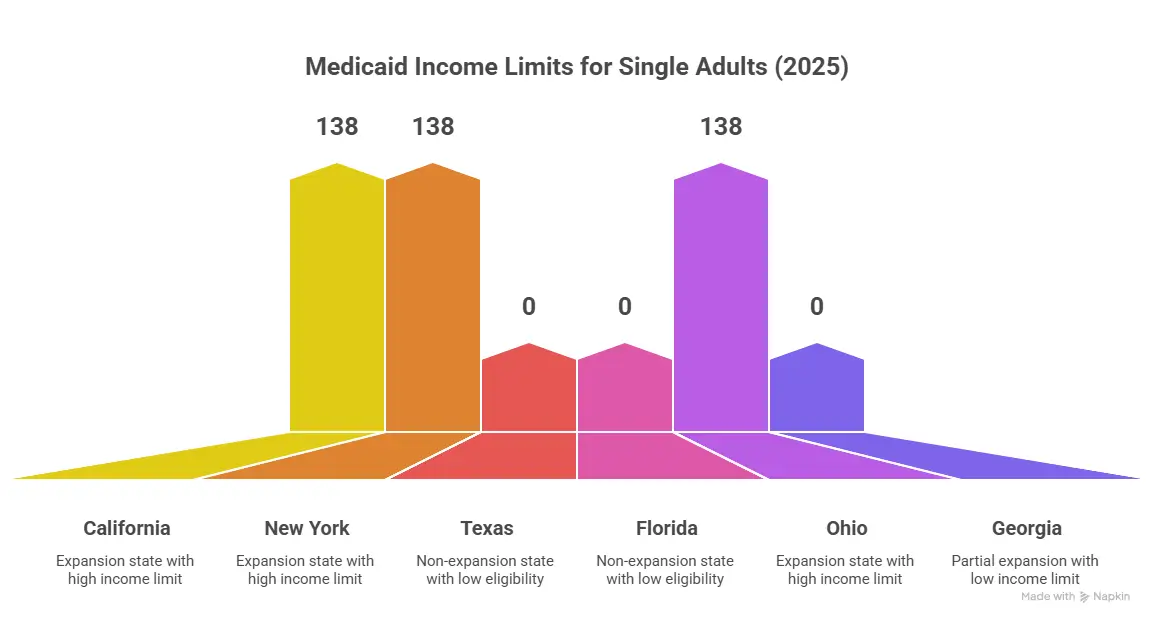
| State | Medicaid Adult Income Limit | What That Means (Single Person, 2025) |
|---|---|---|
| California | 138% of FPL (expansion) | Up to $21,600/year qualifies |
| New York | 138% of FPL (expansion) | Up to $21,600/year qualifies |
| Texas | Non-expansion, very low | Adults usually don’t qualify unless income is far below FPL |
| Florida | Non-expansion, very low | Many adults don’t qualify even at the poverty line |
| Ohio | 138% of FPL (expansion) | Up to $21,600/year qualifies |
| Georgia | Partial / limited expansion | Lower than 138%, often around poverty line |
(Based on 2025 Federal Poverty Guidelines: $15,650 = 100% FPL for a single adult. Source: CMS, HHS, KFF.)
Key Points to Save Time
- Expansion states (like California, New York, Ohio) → Most adults under 65 can qualify up to 138% FPL.
- Non-expansion states (like Texas, Florida) → Very strict; many adults only qualify if they earn much less than FPL.
- Each extra household member raises the income limit by about $5,500 per year.
- Special groups like children, pregnant women, and people with disabilities often qualify at higher income levels.
How to Apply for Medicaid in 2025
Applying for Medicaid in 2025 is simple and free. You can apply any time of the year — there’s no open enrollment period.
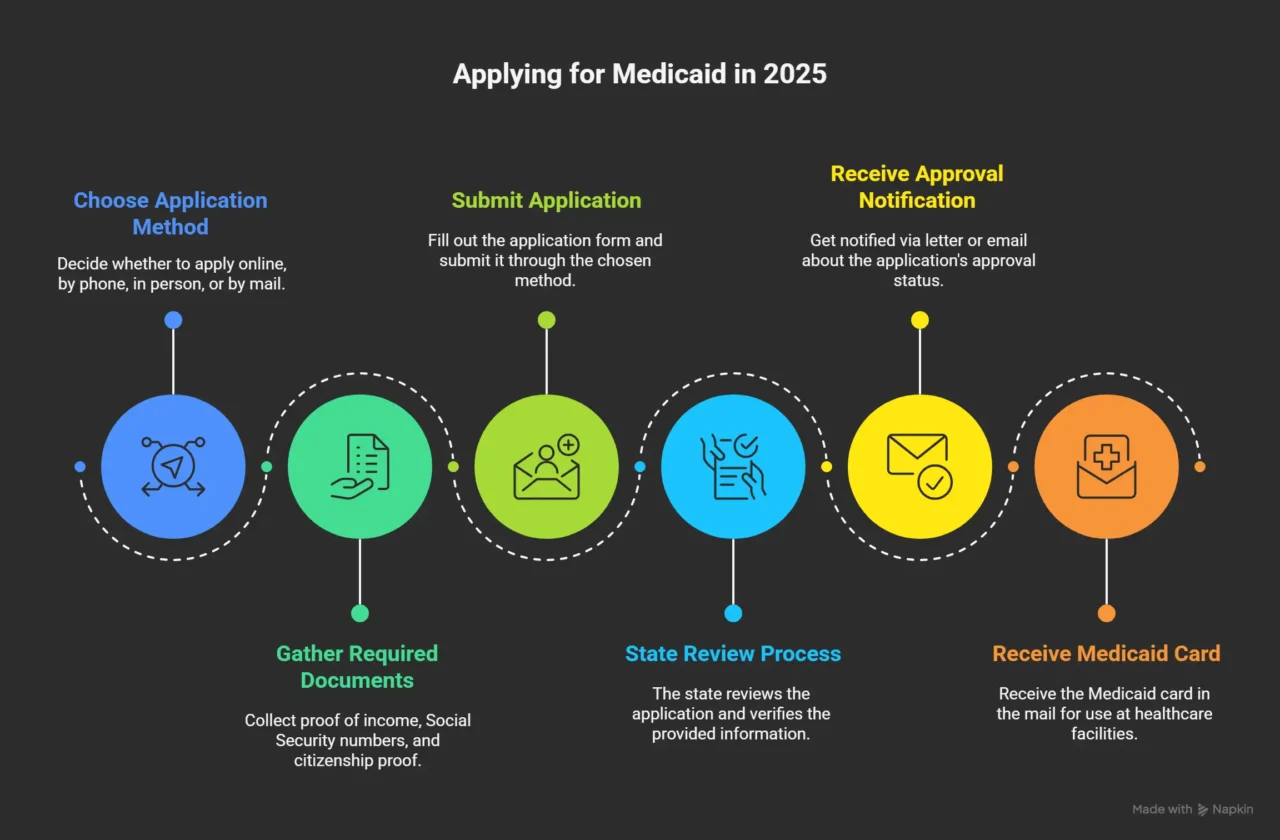
👉 Direct answer: You apply for Medicaid by filling out a form with your income, household size, and personal details either online, by phone, by mail, or in person.
Ways to Apply
- Online
- Go to your state’s Medicaid website.
- Or start at HealthCare.gov and it will send your info to your state.
- By Phone
- Call your state Medicaid office and apply over the phone.
- In Person
- Visit your local Medicaid office, social services office, or a community health center for help.
- By Mail
- Many states let you download a paper form, fill it out, and mail it in.
What You Need to Apply
- Proof of income (like pay stubs or tax return).
- Social Security number for each person applying.
- Proof of citizenship or immigration status.
- Household information (how many people live with you, ages, relationships).
What Happens After You Apply
- The state will check your income and details.
- You’ll get a letter or email saying if you are approved.
- If approved, you’ll get a Medicaid card in the mail to use at the doctor or pharmacy.
👉 Takeaway: In 2025, you can apply for Medicaid anytime, online or in person. Have your income and household info ready, and your state will tell you if you qualify.
What Are Medicaid Income Limits?
Medicaid income limits are the cut-off for how much money you can make and still get Medicaid health insurance.
- The limit depends on how many people live in your house.
- It uses the Federal Poverty Level (FPL), which is updated each year by the government.
- In 2025, most adults in states that expanded Medicaid can qualify if their income is at or below 138% of the FPL.
- Some people (like kids, pregnant women, seniors, and people with disabilities) may qualify even if they earn more.
👉 Simple answer: If your household income is under the Medicaid income limit for your family size, you can get Medicaid in 2025.
Who Qualifies for Medicaid in 2025?
Medicaid is for people with low income who meet certain rules. In 2025, the rules depend on your state, your income, and sometimes your age or health needs.
👉 Direct answer: You may qualify for Medicaid in 2025 if your income is below your state’s limit and you fit into one of these groups.
Main Groups That Can Get Medicaid in 2025
- Children – Most states cover kids in families with income well above the poverty line, often through CHIP (Children’s Health Insurance Program).
- Pregnant women – Many states cover pregnant women at higher income levels than adults without kids.
- Parents and caretakers – Some states cover parents if they live with and care for a child.
- Adults (19–64) – In expansion states, most adults qualify with income up to 138% of the Federal Poverty Level (FPL).
- Seniors (65+) – Older adults can qualify for Medicaid if they also meet income and asset limits. Many get both Medicare and Medicaid (called “dual eligible”).
- People with disabilities – Income and asset rules may be different. Some can qualify even if income is above the usual limit through “spend-down” programs.
Quick Examples (2025)
- A single adult in California earning $20,000/year → Qualifies (expansion state, under 138% FPL).
- A family of 4 in New York earning $40,000/year → Qualifies (under 138% FPL for 4).
- A single parent in Texas earning $15,000/year → May not qualify (non-expansion state).
- A pregnant woman in Florida earning $30,000/year → Often still qualifies (higher pregnancy income limit).
Medicaid Expansion & 2025 Updates
Medicaid expansion means a state chose to cover more adults under Medicaid with incomes up to 138% of the Federal Poverty Level (FPL).
👉 Direct answer: As of 2025, 41 states + DC have expanded Medicaid. In those states, many adults with incomes up to ~$21,597/year (for a single person) qualify. In states that did not expand, many adults still don’t qualify even if they earn close to or above poverty level.
What’s New / Different in 2025
- The federal government reaffirmed the rule: adults up to 138% of FPL can be eligible if their state expanded.
- Some states made small changes, e.g. modifying how resources or income are counted.
- “Work requirements,” “reporting,” or periodic eligibility checks are being discussed or implemented in a few states.
- A few states that don’t have full expansion still offer limited adult coverage, but those limits are much lower.
Special Programs & Exceptions
Sometimes even if your income is above the usual limit, you might still qualify for Medicaid thanks to special rules or exceptions.
👉 Direct answer: You may still access Medicaid if you are “medically needy,” or qualify because of disability, pregnancy, or special age rules.
Main Exceptions & How They Work
- Medically Needy / Spend-Down Programs
- If your income is over the state limit, but you have big medical bills, you can use those to reduce your “counted income.”
- Once your medical costs push your “net income” below the limit, Medicaid covers the rest.
- Pregnancy / Newborns
- Pregnant women often have higher income limits. Some states allow incomes up to ~190% FPL or more for them.
- Coverage often continues for newborns after birth.
- Children
- Children’s programs (including CHIP) often allow much higher income limits than adults.
- Seniors & Disabled
- Different rules for seniors or people with disabilities. Some limits include not just income but also what assets (like savings, home value) you have.
- Automatic or Simplified Eligibility
- In some states, certain people get Medicaid automatically if they already get programs like SSI or SNAP.
- Also, some paperwork or resource counting is simplified to make applying easier.
Frequently Asked Questions (FAQ)
1. What is the income limit for Medicaid in 2025?
Answer: It depends on your state and household size. In expansion states, adults can usually qualify if they earn up to 138% of the Federal Poverty Level (FPL). For a single adult, that’s about $21,600/year.
2. Do all states have the same Medicaid income limits?
Answer: No. Each state sets its own limits. Expansion states have higher limits (up to 138% FPL), while non-expansion states often have much lower limits.
3. Can I qualify if my income is slightly above the limit?
Answer: Maybe. Some states offer “medically needy” or spend-down programs. If you have big medical bills, they can lower your counted income and help you qualify.
4. How does household size affect Medicaid income eligibility?
Answer: Bigger households have higher income limits. For example, a family of four in 2025 may qualify if they earn up to about $44,400/year, while a single adult qualifies up to $21,600/year.
5. Who else qualifies besides low-income adults?
Answer:
Children (often through CHIP)
Pregnant women (higher income limits)
Seniors (65+) and people with disabilities
Some special groups may qualify even if income is above normal limits
6. How do I apply for Medicaid in 2025?
Answer: Apply online, by phone, by mail, or in person. You’ll need your income, household info, and proof of citizenship/immigration status. The state will review your info and send approval if you qualify.
7. How often do I need to check eligibility or renew?
Answer: Most states require annual renewal, but some states are now simplifying checks. Make sure to update your state Medicaid office if your income or household size changes.
Summary
- What it is: Medicaid income limits show how much money you can make to get Medicaid health coverage.
- Federal Poverty Level (FPL): Most states use the FPL. In expansion states, adults can qualify if they earn up to 138% of FPL (~$21,600/year for one adult in 2025).
- State rules differ: Some states cover more adults (expansion states), some cover fewer (non-expansion states).
- Household size matters: Bigger families can earn more and still qualify. Example: a family of four can make up to ~$44,400/year.
- Special groups: Pregnant women, kids, seniors, and people with disabilities may have higher limits. Some programs help if you have big medical bills.
- How to apply: Apply online, by phone, by mail, or in person. Bring income info, household info, and proof of citizenship or immigration status.
- Renewal: Most states check eligibility every year. Report changes in income or family size.
Bottom line: In 2025, Medicaid helps low-income people of all ages get health coverage. Check your state’s Medicaid website to see your limit and apply.

